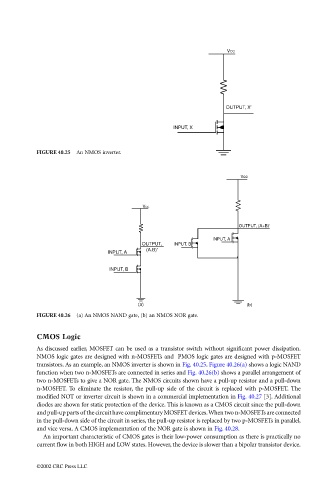Page 1105 - The Mechatronics Handbook
P. 1105
VCC
OUTPUT, X'
INPUT, X
FIGURE 40.25 An NMOS inverter.
Vcc
VCC
OUTPUT, (A+B)'
INPUT, A
OUTPUT, INPUT, B
(A.B)'
INPUT, A
INPUT, B
(a) (b)
FIGURE 40.26 (a) An NMOS NAND gate, (b) an NMOS NOR gate.
CMOS Logic
As discussed earlier, MOSFET can be used as a transistor switch without significant power dissipation.
NMOS logic gates are designed with n-MOSFETs and PMOS logic gates are designed with p-MOSFET
transistors. As an example, an NMOS inverter is shown in Fig. 40.25. Figure 40.26(a) shows a logic NAND
function when two n-MOSFETs are connected in series and Fig. 40.26(b) shows a parallel arrangement of
two n-MOSFETs to give a NOR gate. The NMOS circuits shown have a pull-up resistor and a pull-down
n-MOSFET. To eliminate the resistor, the pull-up side of the circuit is replaced with p-MOSFET. The
modified NOT or inverter circuit is shown in a commercial implementation in Fig. 40.27 [3]. Additional
diodes are shown for static protection of the device. This is known as a CMOS circuit since the pull-down
and pull-up parts of the circuit have complimentary MOSFET devices. When two n-MOSFETs are connected
in the pull-down side of the circuit in series, the pull-up resistor is replaced by two p-MOSFETs in parallel,
and vice versa. A CMOS implementation of the NOR gate is shown in Fig. 40.28.
An important characteristic of CMOS gates is their low-power consumption as there is practically no
current flow in both HIGH and LOW states. However, the device is slower than a bipolar transistor device.
©2002 CRC Press LLC

